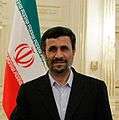Hossein Saffar Harandi
| Sardar Mohammad-Hossein Saffar Harandi | |
|---|---|
 | |
| Minister of Culture and Islamic Guidance | |
|
In office 21 August 2005 – 23 July 2009 | |
| President | Mahmoud Ahmadinejad |
| Preceded by | Ahmad Masjed-Jamei |
| Succeeded by | Mohamamd Hosseini |
| Personal details | |
| Born |
29 September 1953 Gorgan, Iran |
| Alma mater |
Iran University of Science and Technology University of Tehran |
| Religion | Islam |
| Military service | |
| Service/branch | Revolutionary Guards |
| Years of service | 1979–2004, 2009–present |
| Rank | Brigadier General |
Mohammad-Hossein Saffar-Harandi (born 29 September 1953) is an Iranian politician who was minister of culture and Islamic guidance of Iran from 21 August 2005 until 23 July 2009 when he resigned after opposed the appointment of Esfandiar Rahim Mashaei as vice president.
Early life and education
Harandi was born in Gorgan in 1953. He is the nephew of Reza Saffar Harandi, who assassinated Hassan Ali Mansoor, then Iran's prime minister, in 1965.[1]
He graduated from the Iran University of Science and Technology with a degree in civil engineering in 1973. He obtained his master's degree in military sciences in 1993 and completed a certificate on strategic management in 1994.
Career
Harandi was deputy commander of the Islamic Revolutionary Guards Corps (IRGC) in Hormozgan (1981 - 1981),[2] Kerman and other provinces. From 1980 to 1983 he held the post of national regional deputy commander of the IRGC.[2] He was the director of the IRGC's political office from 1989 to 1993.[2]
He was then served as the editor-in-chief and the deputy managing editor of Kayhan.[1] In 2005, he was appointed minister of guidance and culture to the first cabinet of Ahmedinejad.[3] Harandi was approved by the Majlis with 181 votes in favor.[4]
Harandi was removed from office on 26 July 2009.[5] Amid reports of his dismissal he said he was resigning. "Unfortunately due to the recent events which shows the esteemed government's weakness, I will no longer consider myself the minister of culture and will not show up at the ministry as of tomorrow," he said in a letter of resignation carried by the Fars news agency.[6] Analysts described his termination as significant because of his being "especially close" to Iran's supreme leader, Ali Khamenei, and connected to Harandi's support of Khamenei's order to Ahmadinejad to not appoint Esfandiar Rahim Mashaei as vice president.[1][7] Following his dismissal, Harandi returned to the IRGC as brigadier general.[8]
Views
As culture minister, Harandi, had a negative opinion of music. When he assumed his post, he stated that one of the first issues that he would combat would be the types of music that are against the values of the Republic of Iran, including rock and rap. He called upon Iranian musicians to produce purposeful and meaningful music. One result was the composition and production of a "nuclear symphony" in support of Iran's right to develop a nuclear program for peaceful purposes.[9]
Safar-Harandi were infuriated over Ahmadinejad's remarks.[6] He was recently seen at an opposition meeting with leading figures. Safar-Harandi stated he would actively work with the opposition to insure justice is meted out against all those who committed crimes. He was emerging as a leading opponent to the current leadership in 2009.[6]
References
- 1 2 3 Sahimi, Muhammad (26 July 2009). "Ahmadinejad Sacks Ministers; Mashaei to Remain Close". PBS. Retrieved 1 July 2013.
- 1 2 3 Frederic Wehrey; Jerrold D Green; Brian Nichiporuk; Alireza Nader; Lydia Hansell (31 December 2008). The Rise of the Pasdaran: Assessing the Domestic Roles of Iran's Islamic Revolutionary Guards Corps. Rand Corporation. ISBN 978-0-8330-4680-2. Retrieved 5 August 2013.
- ↑ Kazemzadeh, Masoud (2007). "Ahmadinejad's Foreign Policy". Comparative Studies of South Asia, Africa and the Middle East. 27 (2): 423–449. doi:10.1215/1089201x-2007-015. Retrieved 12 February 2013.
- ↑ "Iran: 17 proposed ministers receive votes of confidence, 4 rejected". Payvand. 25 August 2005. Retrieved 1 July 2013.
- ↑ "Iran's Ahmadinejad Dismisses Cabinet Ministers". Radio Free Europe. 26 July 2009. Retrieved 26 June 2013.
- 1 2 3 "Iran intelligence minister sacked". BBC News. 26 July 2009. Retrieved 26 July 2009.
- ↑ Erdbrink, Thomas (27 July 2009). "Two Ministers Forced to Leave Iranian Cabinet Firing and Resignation Indicate Tension Between President and Supreme Leader". Washington Post. Retrieved 30 July 2009.
- ↑ Sahimi, Mohammad (30 October 2009). "The power behind the scene: Khoeiniha". PBS. Retrieved 3 August 2013.
- ↑ Manal Lutfi (26 May 2007). "Iran's Underground Music Revolution". Asharq Al-Awsat. Retrieved 30 July 2009.
| Wikimedia Commons has media related to Hossein Saffar Harandi. |
| Political offices | ||
|---|---|---|
| Preceded by Ahmad Masjed-Jamei |
Minister of Culture 2005–2009 |
Succeeded by Mohammad Hosseini |

